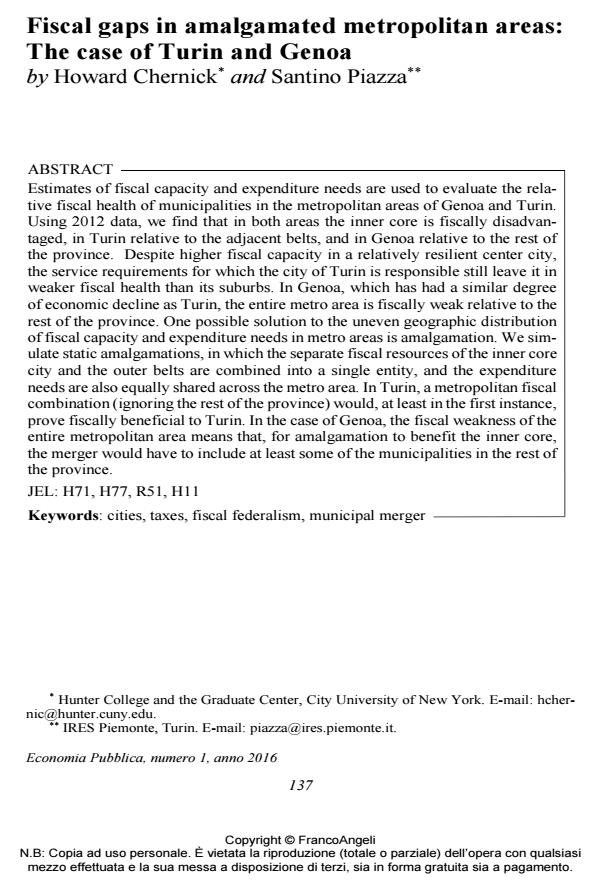Fiscal gaps in amalgamated metropolitan areas: The case of Turin and Genoa
Titolo Rivista ECONOMIA PUBBLICA
Autori/Curatori Howard Chernick, Santino Piazza
Anno di pubblicazione 2016 Fascicolo 2016/1 Lingua Inglese
Numero pagine 35 P. 137-171 Dimensione file 459 KB
DOI 10.3280/EP2016-001007
Il DOI è il codice a barre della proprietà intellettuale: per saperne di più
clicca qui
Qui sotto puoi vedere in anteprima la prima pagina di questo articolo.
Se questo articolo ti interessa, lo puoi acquistare (e scaricare in formato pdf) seguendo le facili indicazioni per acquistare il download credit. Acquista Download Credits per scaricare questo Articolo in formato PDF

FrancoAngeli è membro della Publishers International Linking Association, Inc (PILA)associazione indipendente e non profit per facilitare (attraverso i servizi tecnologici implementati da CrossRef.org) l’accesso degli studiosi ai contenuti digitali nelle pubblicazioni professionali e scientifiche
Estimates of fiscal capacity and expenditure needs are used to evaluate the relative fiscal health of municipalities in the metropolitan areas of Genoa and Turin. Using 2012 data, we find that in both areas the inner core is fiscally disadvantaged, in Turin relative to the adjacent belts, and in Genoa relative to the rest of the province. Despite higher fiscal capacity in a relatively resilient center city, the service requirements for which the city of Turin is responsible still leave it in weaker fiscal health than its suburbs. In Genoa, which has had a similar degree of economic decline as Turin, the entire metro area is fiscally weak relative to the rest of the province. One possible solution to the uneven geographic distribution of fiscal capacity and expenditure needs in metro areas is amalgamation. We simulate static amalgamations, in which the separate fiscal resources of the inner core city and the outer belts are combined into a single entity, and the expenditure needs are also equally shared across the metro area. In Turin, a metropolitan fiscal combination (ignoring the rest of the province) would, at least in the first instance, prove fiscally beneficial to Turin. In the case of Genoa, the fiscal weakness of the entire metropolitan area means that, for amalgamation to benefit the inner core, the merger would have to include at least some of the municipalities in the rest of the province.
Keywords:Cities, taxes, fiscal federalism, municipal merger
Jel codes:H71, H77, R51, H11
- Ahrend R. and Schumann A. (2014). Does Regional Economic Growth depend on proximity to urban centres? OECD WP 7.
- Bagnasco A. (1977). Tre Italie, la problematica territoriale dello sviluppo Italiano. Bologna: il Mulino.
- Calabrese S. and Cassidy G. Epple (2002). Local Government Fiscal Structure and Metropolitan Consolidation, Brookings-Wharton Papers on Urban Affairs. 1-43. DOI: 10.1353/urb.2002.0002
- Cecchini D. (1989). Stadi di sviluppo del sistema urbano italiano. Rivista Economica del Mezzogiorno, 4.
- Chernick H. (1998). Fiscal Capacity in New York: The City Versus the Region. National Tax Journal, National Tax Association. 51(3): 531-40. Testo disponibile al sito: http://www.ntanet.org/NTJ/51/3/ntj-v51n03p531-40-fiscal-capacity-new-york.pdf.
- Chernick H. and Reschovsky A. (2006). Local Public Finance: Issues for Metropolitan Regions. In OECD (ed.). Competitive Cities in the Global Economy. DOI: 10.1787/9789264027091-18-en
- Chernick H. and Reschovsky A. (2015). The Fiscal Condition of U.S. Cities: Revenues, Expenditures, and the “Great Recession”. Mimeo.
- Chernick H. and Tkacheva O. (2002). The Commuter Tax and the Fiscal Cost of Commuters in New York City. State Tax Notes. 25(6).
- Chernick H. and Piazza S. (2015). Fiscal health and the cities: an application to Italian metropolitan areas, Mimeo.
- Cheshire P.C. and Hay D.G. (1989). Urban Problems in Western Europe: an economic analysis, Hyman.
- Cirilli A. and Veneri P. (2011). Understanding the Determinants of Urban Growth: A Study on the Major Italian Cities. Rivista italiana degli economisti, 3: 477-506.
- COPAFF (2012). Determinazione dei Fabbisogni standard complessivi per i comuni. Testo disponibile al sito: http://www.tesoro.it/ministero/commissioni/copaff/documenti/Nota_Metodologica_Fabbisogni_Comuni_FC01B_x20-12-2012x.pdf.
- Duncombe W. and Yinger J. (2000). Financing higher student performance standards: the case of New York State. Economics of Education Review, 19: 363-386.
- Fuà G. (1983). L’industrializzazione nel nord est e nel centro. In: Fuà G., Zacchia C. (a cura di). Industrializzazione senza fratture. Bologna: il Mulino.
- Glaeser E.L., Scheinkman J.A. and Shleifer A. (1995). Economic growth in a cross-section of cities. Journal of Monetary Economics. 36(1): 117-143. DOI: 10.3386/w5013
- Haughwout A. (2010). Management of Large City Regions: Designing Efficient Metropolitan Fiscal Policies. Journal of Regional Science. 50(1): 401-421. DOI: 10.1111/j.1467-9787.2009.00659.x
- Haughwout A. and Inman R.P. (2002). Should suburbs help their Central city? Brookings-Wharton Papers on Urban Affairs.
- Haughwout A., Inman R., Craig S. and Luce T. (2003). Local Revenue Hills: Evidence from U.S. Cities. Review of Economics and Statistics, 86(2): 570-585.
- Hill E., Wolman H., Kowalczyk K. and St. Clair T. (2012). Forces Affecting City Population Growth or Decline: The Effects of Inter-Regional and Inter-Municipal Competition. In: Rebuilding America’s Legacy Cities: New Directions for the Industrial Heartland. New York: American Assembly.
- Hollar M.K. (2011). Central Cities and Suburbs: Economic Rivals or Allies? Journal of Regional Science. 51(2): 231-252. DOI: 10.1111/j.1467-9787.2010.00701.x
- Imazeki J. and Reschovsky A. (2004). Estimating the Costs of Meeting the Texas Educational Accountability Standards. Mimeo.
- Jacobs J. (ed.) (1969). The economy of cities. New York: Random House.
- Ladd H.F. and Yinger J. (1991). America’s Ailing Cities: Fiscal Health and the Design of Urban Policy. Baltimore: Johns Hopkins Press.
- Meloche J. and Vaillancourt F. (2013). Public finance in Montréal: in search of equity and efficiency. Toronto, Ontario: Institute on Municipal Finance and Governance, Munk School of Global Affairs, Beaconsfield, Quebec: Canadian Electronic Library, 2013. 2014.
- Series: IMFG papers on municipal finance and governance, no. 15.
- SOSE, IFEL (2014). La stima della capacità fiscale dei comuni. October 24th version. Testo disponibile al sito: http://www.finanze.it/export/sites/finanze/it/.content/Documenti/statistiche/Relazione_capacita_fiscale_integrazioni_stabilita_1_24_03_14.pdf.
- Voith R. (1992). City and suburban growth? Substitutes or complements. Business Review.
- Voith R. (1998). Do Suburbs need cities? Journal of Regional Science, 38(3): 445-464. DOI: 10.1111/0022-4146.00102
Howard Chernick, Santino Piazza, Fiscal gaps in amalgamated metropolitan areas: The case of Turin and Genoa in "ECONOMIA PUBBLICA " 1/2016, pp 137-171, DOI: 10.3280/EP2016-001007